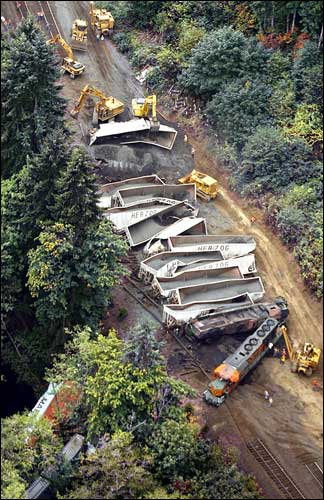Vadar, WA 9-15-2002

Following excerpt was taken from the Seattle Times online. Monday, September 16, 2002 - 12:00 a.m. Pacific
2 men hurt, 20 cars derailed in Lewis County train crash
By J.J. Jensen and Jack Broom
Seattle Times staff reporters
VADER, Lewis County — Two crew members suffered only minor injuries early yesterday morning when a maintenance train rear-ended a freight train, and more than 20 cars derailed on the Burlington Northern Santa Fe main line, just south of Vader.
The wreck, which closed the busy line, occurred around 1:30 a.m. The engineer of the maintenance train, traveling at more than 40 mph, applied the emergency brakes, but the train slammed into the back of the freight train.
The maintenance train, heading from Vancouver, Wash., to Bellingham, was hauling a load of rail rocks. The freight train, traveling from Portland to Tacoma, was carrying empty containers.
Both trains had two-person crews. The two men in the maintenance train were hurt but were treated at the scene, said BNSF spokesman Gus Melonas. A small fire that initially broke out in the engine was quickly extinguished.
"Fortunately, there were only minor injuries," Melonas said. He added that, considering the amount of daily traffic on this line, the accident "is an extremely rare occurrence."
Fifty trains use the line daily, including eight Amtrak passenger trains. Amtrak yesterday bused passengers around the accident, while some freight trains used alternate routes.
Amtrak spokeswoman Liz O'Donoghue said the main line was closed from Kelso to Centralia. About 1,700 passengers on the Cascade service, from Vancouver, B.C., to Eugene, Ore., and on the Coast Starlight route, from Seattle to Los Angeles, were affected yesterday, she said.
But trains were running normally north of Seattle and south of Portland, she added.
At Seattle's King Street Station, many southbound travelers were disappointed to learn they'd be riding on chartered buses instead of a train. "I feel safer on a train, and I can get up and stretch my legs," said Tam Peterson, 30, of Seattle, heading to Portland to visit her parents.
Doug Wallway, of Vancouver, Wash., said he and his wife visited Seattle over the weekend and were looking forward to returning home by rail.
"I haven't taken a train for years, and I thought it would be fun," Wallway said. "Buses are boring."
Among those arriving for a scheduled 1:45 p.m. southbound train, some were told about the switch at the ticket windows. Others, who had purchased tickets ahead of time, bypassed the ticket counter and didn't find out until they were in line chatting with other passengers.
BNSF hopes to have the line reopened by early today, Melonas said.
Mark Baker, who lives about a half mile from the crash site, was out yesterday afternoon trying to get a better view of the accident, which was not visible from nearby roads or houses.
He was awake when the wreck happened and initially thought it was an explosion.
"I thought a gas station blew up," Baker said. "I've lived here for three years, and I've never heard anything like this."
More than 50 people from various agencies worked to clear the site yesterday and investigate how the accident happened.
An unspecified amount of diesel fuel spilled, but was contained and cleaned. It did not pose an environmental threat, Melonas said.
BNSF officials said getting to the crash site was a struggle because the only way in was on a small, one-lane dirt road.
South of the wreck, beneath the changing colors of maple trees, a staging area was set up that looked like a sea of 4x4 trucks, flatbeds and bulldozers.
From the air, the derailed containers looked like a folded accordion between the steep, heavily wooded ridges on both sides of the tracks. Several cars had toppled near a small creek.
Before the line can reopen, crews must remove some cars from the track and re-rail others. Some work must also be done to damaged rails.
The Vader accident was the first major train accident in the state since 1993, when Burlington Northern and Union Pacific trains collided near Kelso, killing five crew members.
Melonas said there are a variety of ways trains are monitored. Conductors keep in constant radio contact with other conductors and a national network operation center, and signals indicate when trains are in front of them.
J.J. Jensen: 206-464-2386 or jjensen@seattletimes.com. Seattle Times news assistant J.C. Santos contributed to this report.
Copyright © 2002 The Seattle Times Company